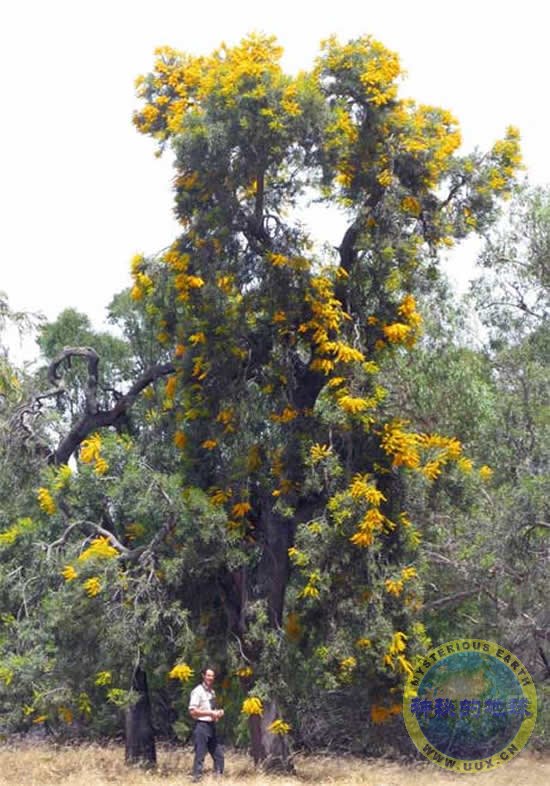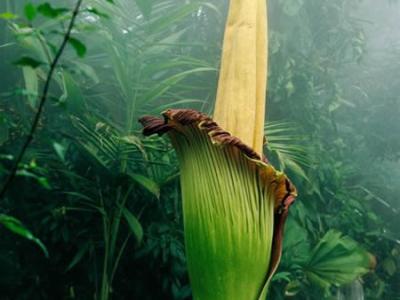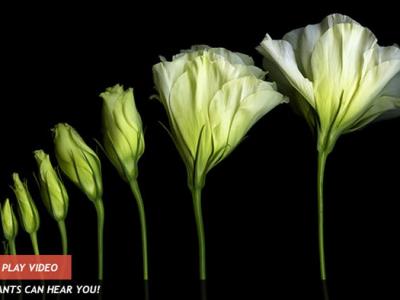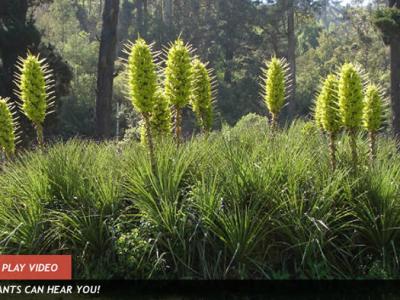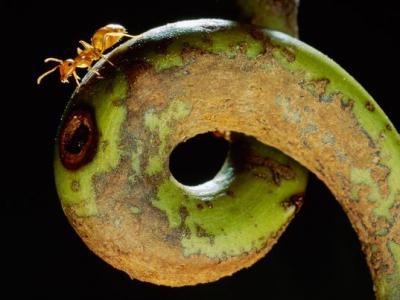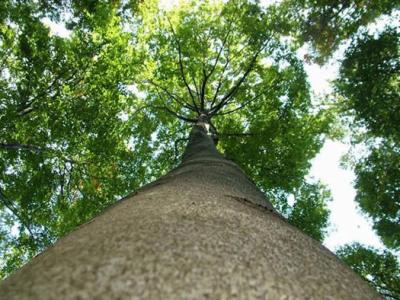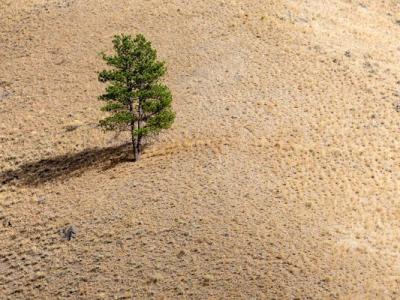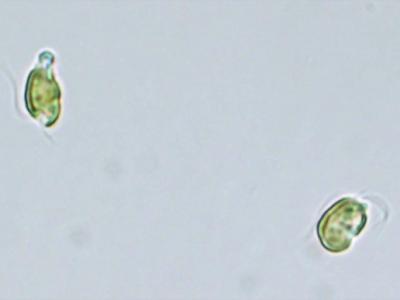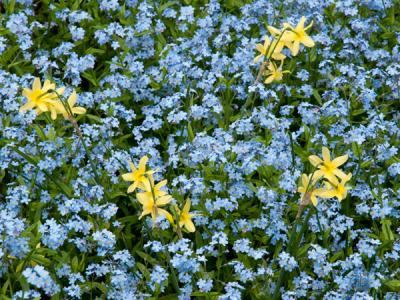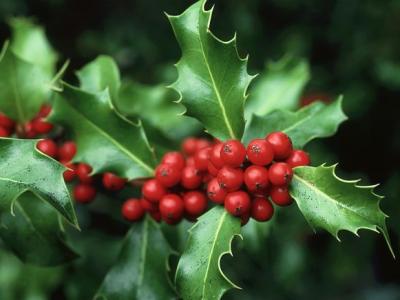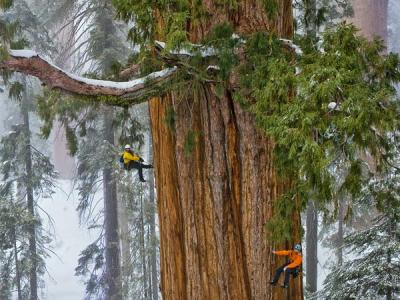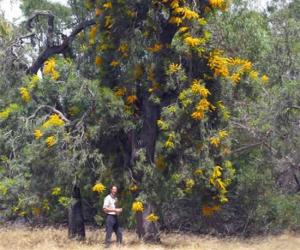Mistletoe "Keystone" to Forest Health, Scientists Say
Ecologist David Watson stands under a West Australian Christmas tree, one of the worlds largest mistletoes.
The parasitic plants play a surprisingly large role in the well-being of forest plants and animals by producing flowers, berries, and leaves continuously—even in the winter—experts say.
Photograph by David Watson
Aalok Mehta
National Geographic News
December 24, 2007
Mistletoe, it turns out, is important for far more than sneaking in smooches during the holidays.
The parasitic plants are a vital member of many types of forests—and may even be the key to renewing ailing woodlands, according to ongoing research.
"Even though mistletoe represents a minor component of the habitats it inhabits, in terms of species richness, abundance, and biomass, it has a disproportionately strong and pervasive influence on diversity patterns," said David Watson, an associate professor of ecology at the Institute for Land, Water, and Society at Charles Sturt University in Albury, Australia.
In 2001 Watson wrote a paper outlining mistletoe's role as a "keystone resource" that helps increase the diversity and abundance of wildlife in forest environments.
The plant serves as a nesting ground and food source for many animals, often increasing the number of species in its vicinity, Watson said.
Since then additional research has shed light on just how important mistletoe is to the overall health of woodland plants and animals.
Holiday Aphrodisiac
Mistletoe can refer to approximately 1,500 or so parasitic plants that live high above the ground in trees or shrubs around the world.
Unlike other plant parasites, especially those that live underground, mistletoe makes its own energy through photosynthesis and relies on its hosts mostly for water and minerals. Though it sometimes kills its hosts, usually it does little more than stunt their growth.
The plant is best known as a hanging Christmas decoration under which men and women are obliged to kiss—a ritual that may owe its origins to mistletoe's long association with aphrodisiacs.
But mistletoe is also a key player in myths such as the death of the Norse god Baldur, and has symbolic importance in many other cultures.
Ancient Britain's Druids may have used the plant in their winter solstice ceremonies, for instance, since mistletoe remains growing and green around that time when most other plants appear lifeless, lending the plant a mystical aura.
The Flipside of Littering
This year-round growth is a key to mistletoe's importance, Watson pointed out.
The plant produces flowers, berries, and leaves continuously—even during the winter, when trees and shrubs have gone bare in order to conserve energy and resources—providing a food source for foraging animals.
But fallen mistletoe leaves also serve as a key element of overall forest health, according to soon-to-be-published research.
"Weve discovered that leaf litter may be one of the key mechanisms through which mistletoe influences overall forest dynamics and diversity patterns," Watson said.
"[Leaf litter] is the main source of carbon and a whole lot of other 'raw materials' that are used by microbial communities to form soil, the engine that drives aboveground productivity and growth."
"Fallback" Food
Other recent research is bolstering Watson's finds.
For example, Mitchell Irwin, a postdoctoral biology fellow at McGill University in Montreal, Quebec, studies sifakas, a type of lemur found only on Madagascar.
"I didn't particularly go there to study mistletoe, but it turned out that it was the most important story for lemur survival," he said.
During the island's wet season, the lemurs can find plenty of fruit, their preferred meal, he pointed out.
"Yet in the dry season, the trees are almost unanimously holding out and not producing any good foods," he said. "So the sifakas turn to the mistletoes ... eating a ton of their flowers, fruits, and young leaves. In ecological terms we call this a 'fallback food.'"
No one knows why mistletoe reproduces all year long, but it probably has to do with its parasitic nature, he added. Mistletoe may not experience the stress of dealing with dry soil since it leeches its water supply directly from its host.
"I think it is debatable whether [the lemurs] could survive the dry season at Tsinjoarivo [a Madagascar rain forest site] if there weren't mistletoes—they are fairly large lemurs and thus have fairly high energy requirements," Irwin said.
"As it is, sifakas already lose body mass in the dry season, so without mistletoes the stress may be too much to survive."
Stay-At-Home Sons
Janis Dickinson, a professor of natural resources at Cornell University in Ithaca, New York, has meanwhile found that mistletoe is crucial for western bluebirds.
The plant provides a winter food source that can keep young males home with their parents, allowing the birds to build thriving cooperative family units, she said.
"The mistletoe is probably what gets [the bluebirds] through the cold spells when insects are not active," she added. "It provides a constant berry crop all winter long and is clumped in its distribution."
All the new findings suggest to Watson, the Australian researcher, that mistletoe could help cure certain kinds of ailing forests.
Tropical forests are probably poor candidates, since mistletoe's importance is reduced by the presence of plants with similar keystone roles, such as figs.
But for other kinds of struggling forests, managing and reintroducing mistletoe is "most definitely" a potential solution, he said.
"I have advocated this for restoring certain habitats."
McGill's Irwin agreed.
"I have read things saying that foresters in the past used to want to kill mistletoes in order to promote the health of the trees," he said, "but of course recent research shows that to be a bit stupid."
